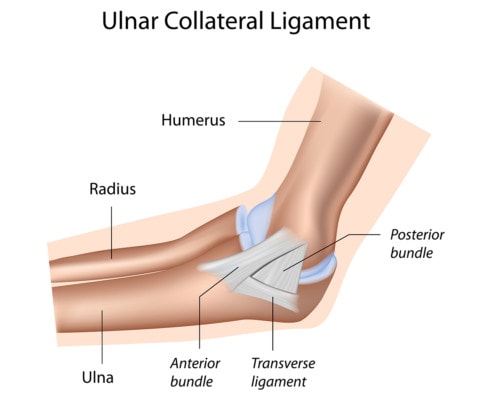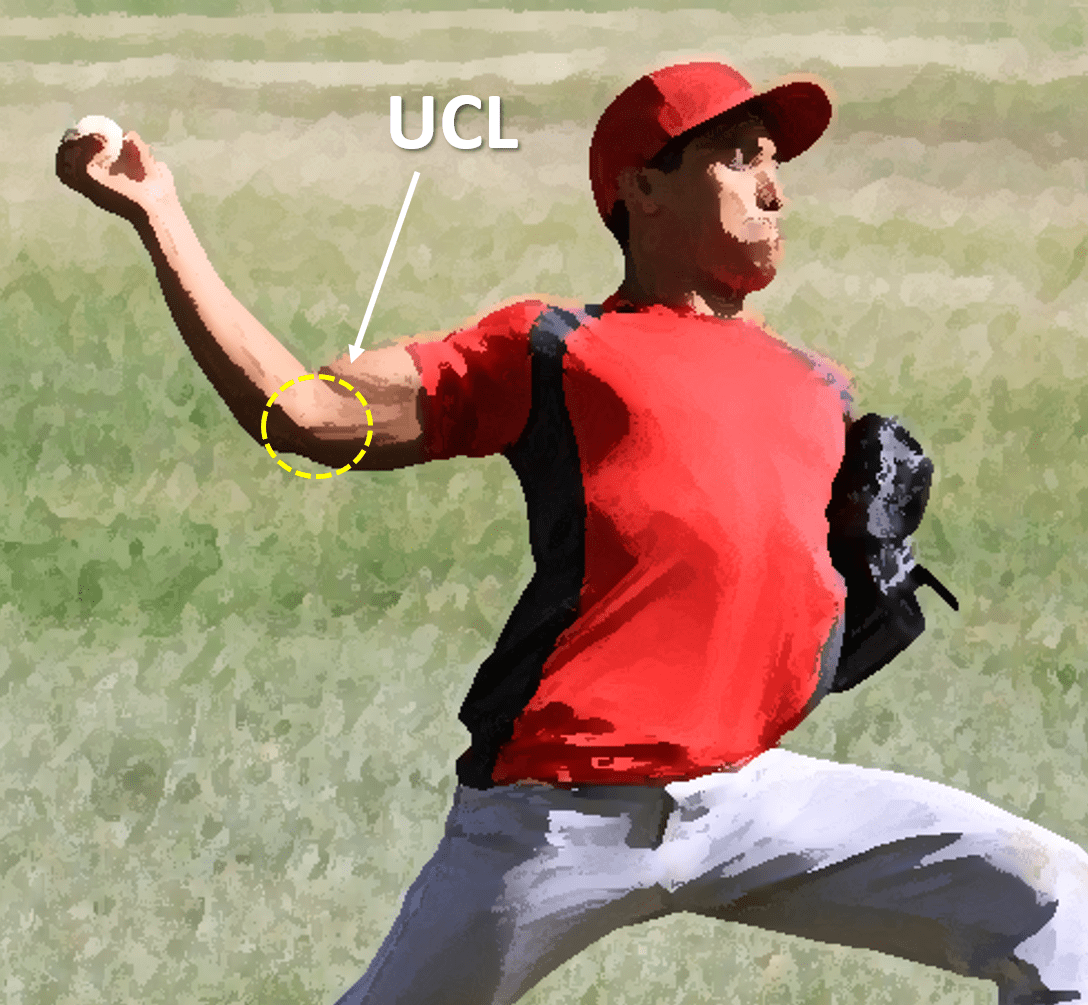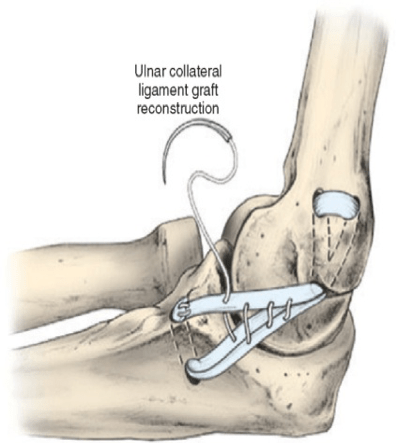Why Tommy John Doesn’t Like the Surgery that Bears His Name
You can’t be around modern baseball and not hear about Tommy John surgery. So what is that surgery and what does it treat? Why is its namesake now increasingly against the procedure? Let’s dig in.
What Is Tommy John Surgery?
Way back in 1974, a famous pitcher for the LA Dodgers named Tommy John had an elbow problem. His pitching style, while wildly successful, put tremendous pressure on his elbow ulnar collateral ligament (UCL). What’s that?

Alila Medical Media/Shutterstock
The UCL is the ligament that lives on the inside of the elbow that acts as the duct tape that helps holds together the joint. The ligament in pitchers gets tremendous stretch during a throw:

Michael Mitchell/Shutterstock
Since Tommy John had a UCL tear, he got a new reconstructive surgery on that ligament:
Like all such surgeries, this one takes a tendon and drills holes and then threads the tendon to replace the damaged ligament (see above). The complication rate for this surgery is 10-20% and can include damage to the ulnar nerve which controls the movements of the hand (1).
Why Does Tommy John Not Like UCL Reconstruction Surgery?
I came across an article the other day that I had never seen that had the following quote from Tommy John (8):
“It doesn’t bother me to watch my legacy being upstaged by an operation that has saved plenty of ballplayers’ careers. What does bother me is that my name is now attached to something that affects more children than pro athletes. I was in my 30s and playing major league ball for nearly a dozen years before needing the operation. Today, 57 percent of all Tommy John surgeries are done on kids between 15 and 19 years old. One in 7 of those kids will never fully recover.
But this is about more than just baseball and elbows. It’s about the way we are raising our children. The nation’s youth-sports industry is a $15 billion business — and more and more, that business pushes children to make decisions early about which sport they want to play, and then to pursue that sport to the exclusion of all others. And kids’ bodies are paying the price. The rate of ACL tears in kids has been increasing by 2.3 percent per year for two decades, and about 1 in 5 teens in contact sports have had at least one concussion. And if a child is spending more than eight months annually in one sport, he or she is nearly three times more likely to experience an overuse injury in their hip or knee.”
What Tommy John is speaking to here is something I’ve been blogging on for years. A baseball or football player trying to seek out another few years of a multi-million dollar contract is nothing like a kid who gets a UCL or ACL injury. Yet parents are increasingly pushing kids to get these VERY aggressive orthopedic surgeries. Why? On the surface, it’s the “Tommy John” effect. Meaning that a celebrity sports figure got the surgery and returned to play. But what the parents don’t see is that these guys are physically wrecked by the time they hit their 30s and 40s. They are functionally 1-3 decades older than their peers who never got these catastrophic injuries and big surgeries.
Teens Getting Big Surgeries
Whenever I see someone in their late 20s to early 30s walk into my office with an arthritic elbow or knee, you can bet big money that they had big orthopedic surgeries like UCL or knee ACL reconstruction as teens. By that time they’ve usually had several procedures. This isn’t my imagination, as for example, the research shows that most teens that get ACL reconstruction will have knee arthritis by age 30 (2). We also know that the surgery itself is a second hit to the cartilage (3). Why? Think about it, we’re drilling holes in these joints to string tendons to replace ligaments. Doing that is like dropping a second thermonuclear device of inflammation inside the elbow or knee.
Why are we doing this to our kids? It’s also not just parents, as every orthopedic surgery practice worth its salt has banner ads that run at every youth field around the country.
Is There a Better Way?
About 2/3rds of these UCL and ACL tears can be treated without surgery by using the precise injections of orthobiologics (4-7). These procedures don’t rip out damaged ligaments and then drill holes and string tendons, they instead ramp up the normal repair processes to help the damaged ligament heal. They are the perfect procedures for teens who have amazing healing potential. That’s why the truly smart pros are now skipping these surgeries and trying these newer and less invasive orthobiologic injections. Truly smart parents should be doing the same.
The upshot? If you’re a parent of a gifted athlete, please don’t rush into these big surgeries. Listen to Tommy John the retired pitcher. Your kids will thank you when they start having their own kids and at that young age don’t need an elbow or knee replacement!
_____________________________________
References:
(1) Vitale MA, Ahmad CS. The outcome of elbow ulnar collateral ligament reconstruction in overhead athletes: a systematic review. Am J Sports Med. 2008 Jun;36(6):1193-205. doi: 10.1177/0363546508319053. PMID: 18490476.
(2) Friel NA, Chu CR. The role of ACL injury in the development of posttraumatic knee osteoarthritis. Clin Sports Med. 2013;32(1):1-12. doi:10.1016/j.csm.2012.08.017
(3) Hunt ER, Jacobs CA, Conley CE, Ireland ML, Johnson DL, Lattermann C. Anterior cruciate ligament reconstruction reinitiates an inflammatory and chondrodegenerative process in the knee joint. J Orthop Res. 2020 Jun 19. doi: 10.1002/jor.24783. Epub ahead of print. PMID: 32558951.
(4) Centeno CJ, Pitts J, Al-Sayegh H, Freeman MD. Anterior cruciate ligament tears treated with percutaneous injection of autologous bone marrow nucleated cells: a case series. J Pain Res. 2015;8:437–447. https://www.ncbi.nlm.nih.gov/pubmed/26261424
(5) Centeno C, Markle J, Dodson E, et al. Symptomatic anterior cruciate ligament tears treated with percutaneous injection of autologous bone marrow concentrate and platelet products: a non-controlled registry study. J Transl Med. 2018;16(1):246. https://www.ncbi.nlm.nih.gov/pubmed/30176875
(6) Koch M, Mayr F, Achenbach L, et al. Partial Anterior Cruciate Ligament Ruptures: Advantages by Intraligament Autologous Conditioned Plasma Injection and Healing Response Technique-Midterm Outcome Evaluation. Biomed Res Int. 2018;2018:3204869. https://www.ncbi.nlm.nih.gov/pubmed/30148163
(7) Dines JS, Williams PN, ElAttrache N, Conte S, Tomczyk T, Osbahr DC, Dines DM, Bradley J, Ahmad CS. Platelet-Rich Plasma Can Be Used to Successfully Treat Elbow Ulnar Collateral Ligament Insufficiency in High-Level Throwers. Am J Orthop (Belle Mead NJ). 2016 Jul-Aug;45(5):296-300. PMID: 27552453.
(8) AARP Magazine. Why Tommy John Is Against the Surgery That Bears His Name. Accessed 2/5/21. https://www.aarp.org/health/conditions-treatments/info-2018/tommy-john-opposes-namesake-surgery.html

If you have questions or comments about this blog post, please email us at [email protected]
NOTE: This blog post provides general information to help the reader better understand regenerative medicine, musculoskeletal health, and related subjects. All content provided in this blog, website, or any linked materials, including text, graphics, images, patient profiles, outcomes, and information, are not intended and should not be considered or used as a substitute for medical advice, diagnosis, or treatment. Please always consult with a professional and certified healthcare provider to discuss if a treatment is right for you.

